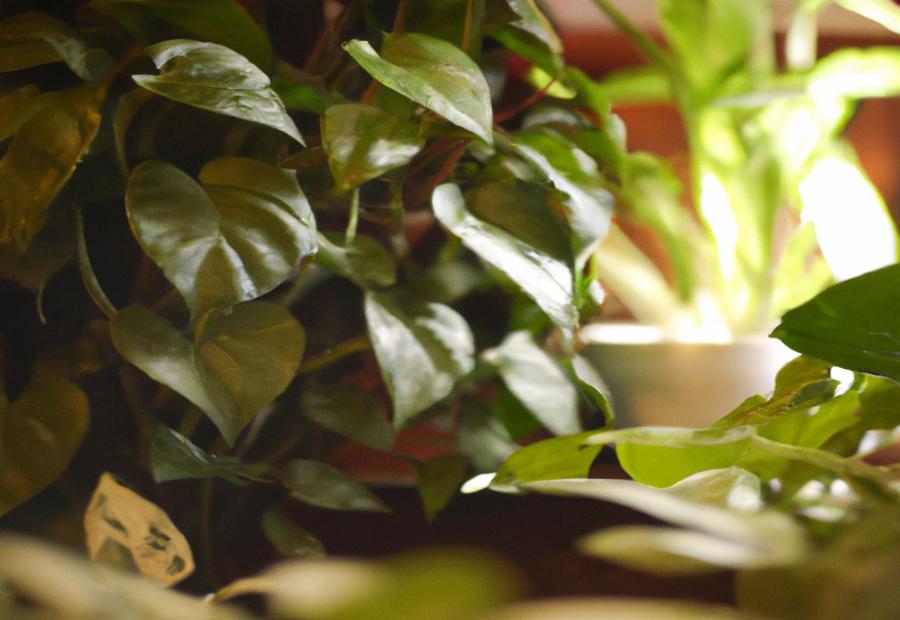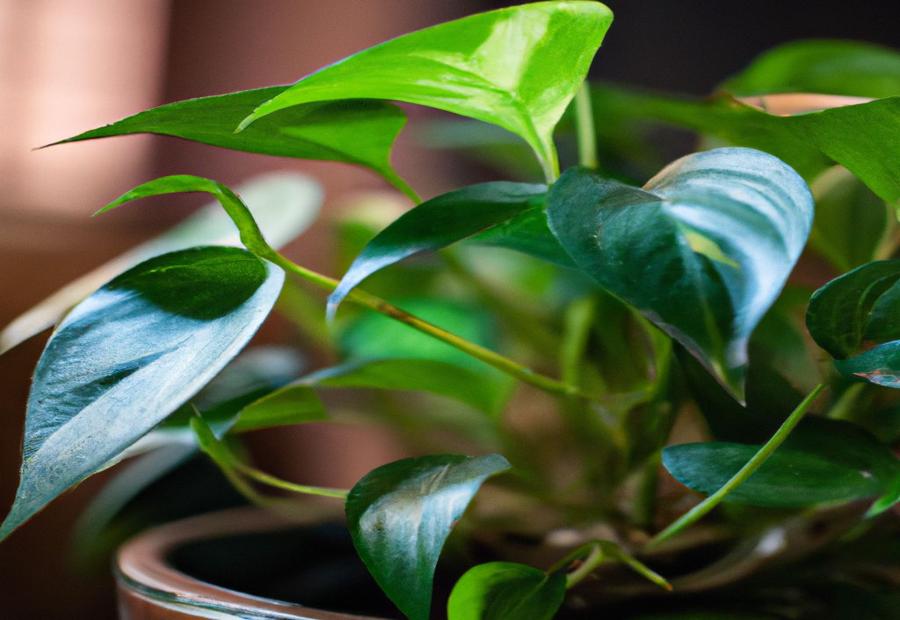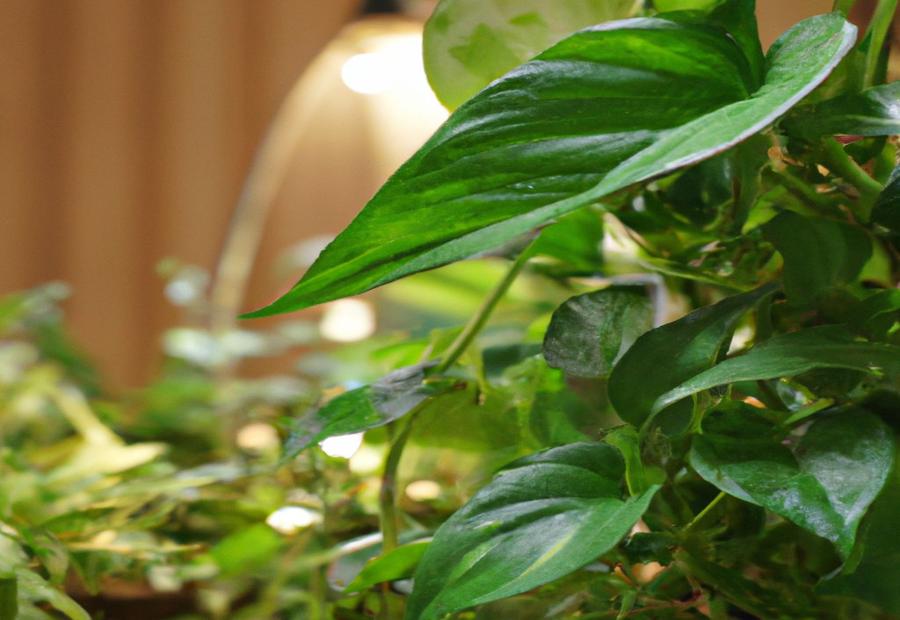Pothos, also known as Devil’s Ivy, is a popular and low-maintenance houseplant known for its trailing vines and vibrant foliage. When it comes to cultivating Pothos, it’s essential to provide the right growing conditions and soil composition. How to care for Marble Queen Pothos is important to ensure the health and growth of Pothos plants.
But what exactly is perlite? Perlite is a type of volcanic glass that is processed into small, lightweight, and porous particles. It is often added to potting mixes to improve drainage, aeration, and moisture retention. In the case of Pothos, perlite can offer numerous benefits that promote its overall well-being and vigor.
Understanding how perlite benefits Pothos is essential. Perlite helps prevent compacted soil, ensuring optimal oxygen and nutrient availability to the roots. It aids in efficient drainage, preventing root rot and waterlogged conditions. Perlite improves soil aeration, allowing the roots to breathe and preventing suffocation.
Determining the correct amount of perlite to use for Pothos depends on various factors. These include the moisture requirements of the plant, the size and type of the pot, and the surrounding environmental conditions. Striking the right balance is crucial to avoid overdrainage, which can lead to excessive water loss and nutrient deficiencies.
Incorporating perlite into the soil is a straightforward process. By mixing perlite with the potting mix, it ensures an evenly distributed and well-aerated growing medium for the Pothos. Following a guide on how to grow giant Pothos and using appropriate ratios will help achieve the desired results without overwhelming the soil.
While perlite is an excellent option for improving soil conditions for Pothos, there are alternatives worth considering. Materials such as vermiculite, pumice, and coarse sand can provide similar benefits, depending on their availability and suitability for the plant’s needs.
Understanding how to use perlite for Pothos and considering alternative substitutes enables plant enthusiasts to customize their soil mixtures tailored to the specific requirements of their Pothos plants. By providing the right growing conditions, Pothos can thrive and bring beauty to any indoor space.
What is Perlite?

Photo Credits: Allotinabox.Com by Robert Davis
Perlite is a naturally occurring volcanic glass that is expanded through a rapid heating process.
How to Make Pothos Grow Faster in Water
What is Perlite? It is used in gardening and horticulture as a lightweight growing medium for plants.
Perlite has excellent water-holding capabilities, ensuring proper drainage and preventing root rot. It also helps to improve aeration and create a well-balanced soil environment for plants to thrive.
One interesting fact about perlite is that it is sterile and free from any harmful pathogens or weed seeds, making it a safe and reliable medium for plant growth. Its neutral pH level also makes it suitable for a wide range of plants and gardening applications.
When choosing perlite for your plant, make sure to look for a high-quality product that is coarse and lightweight. It should have a bright white color and be free of impurities or contaminants. Incorporating perlite into your gardening routine can significantly improve the overall health and growth of your plants.
Remember, using perlite in combination with other growing mediums can maximize its benefits and ensure optimal plant development. Whether you are an experienced gardener or a beginner, perlite is a versatile and valuable addition to enhance your gardening experience.
So, next time you’re considering the best growing medium for your plants, keep perlite in mind for its numerous advantages in promoting healthy and thriving plant growth. What is Perlite?
Why is Perlite used for Pothos?
Perlite is used for Pothos because it provides essential benefits for the plant’s growth. The lightweight volcanic rock known as perlite improves soil drainage and aeration, preventing excess water from sitting in the pot. This helps to prevent root rot and enhances the overall health of the Pothos.
The use of perlite also aids in moisture retention while allowing excess water to easily drain away. This prevents overwatering and ensures that the roots receive the right amount of water and nutrients.
One of the reasons why perlite is used for Pothos is because it is sterile and does not harbor any diseases or pests. This creates a clean and healthy environment for the plant.
Additionally, perlite helps to prevent soil compaction, allowing the roots of the Pothos to spread and grow more freely. This promotes healthier root development and better overall growth for the plant.
How Does Perlite Benefit Pothos?

Photo Credits: Allotinabox.Com by Gary Thomas
How Does Perlite Benefit Pothos?
- Improved Drainage: Perlite, a lightweight volcanic rock, is added to potting mixes to enhance drainage. By mixing perlite with soil, air spaces are created, allowing excess water to drain away from the roots of the pothos plant. This prevents root rot.
- Increased Aeration: Pothos plants require well-aerated soil to thrive. Incorporating perlite into the potting mix promotes airflow within the soil, supplying oxygen to the roots and fostering healthy growth.
- Reduced Compaction: Over time, potting mixes can become compacted, restricting root penetration and nutrient absorption. The use of perlite prevents compaction by creating a loose and porous environment, enabling unrestricted root growth.
- Root Development: Perlite provides an ideal medium for root development in pothos plants. Its lightweight composition facilitates easy root penetration and establishment, resulting in optimal root growth.
- Prevention of Waterlogged Soil: Pothos plants prefer slightly moist soil but cannot tolerate waterlogged conditions. Adding perlite to the potting mix regulates moisture levels by facilitating excess water drainage, thereby preventing waterlogging.
Perlite, a volcanic mineral, was initially discovered on the Dodecanese island of Milos in Greece during the 19th century. Its exceptional properties, such as its lightweight nature and ability to retain water while improving drainage, quickly made it a valuable additive in horticulture. Since then, perlite has found applications in various fields, including its use in potting mixes for indoor plants like pothos, where its benefits in promoting healthy plant growth have been evident.
How Much Perlite Should be Used for Pothos?
When it comes to growing pothos plants, one essential factor to consider is the amount of perlite to use. But just how much perlite does your pothos need? In this section, we’ll uncover the secrets to determining the ideal perlite amount for your pothos plants. From the factors that influence the perlite quantity to expert tips and insights, get ready to discover the key to optimal pothos growth. Let’s dig in and find the perfect perlite balance!
Factors to Consider when Determining Perlite Amount
When determining the amount of perlite to use for your Pothos plant, Factors to Consider when Determining Perlite Amount are:
- Pot size: The size of your pot will play a role in determining the amount of perlite needed. For smaller pots, you may only need a small handful, while larger pots may require several cupfuls.
- Drainage needs: Pothos plants prefer well-draining soil, so if your pot has poor drainage, you may need to use more perlite to ensure proper water flow.
- Watering habits: If you tend to water your Pothos plant frequently, using a higher percentage of perlite can help prevent waterlogged soil and root rot. On the other hand, if you water less frequently, you can use less perlite.
- Environmental conditions: If you live in a humid climate, using more perlite can help keep the soil from becoming too compacted and retain moisture. In drier climates, less perlite may be needed to prevent the soil from drying out too quickly.
It’s important to keep in mind that there is no exact measurement for perlite amount as it can vary depending on these Factors to Consider when Determining Perlite Amount. It’s best to start with a mixture of potting soil and perlite and observe how the plant responds. If the soil stays too wet or the roots seem suffocated, you can increase the amount of perlite in subsequent repottings. On the other hand, if the soil dries out too quickly, you can decrease the amount.
Experimenting with different perlite amounts will help you find the perfect balance for your Pothos plant, ensuring optimal growth and a healthy root system.
How to Incorporate Perlite into Pothos Soil?
Looking to give your beloved Pothos plants a boost?
Learn how to incorporate the magic ingredient, Perlite, into their soil to enhance their growth and vitality.
We’ll walk you through a step-by-step guide on mixing Perlite with soil, unveiling the secrets to creating the perfect soil blend for your Pothos plants.
Prepare to witness their luscious green foliage flourish like never before!
Let’s dig into the art of perfecting Pothos soil composition.
Step-by-Step Guide on Mixing Perlite with Soil
Here is a step-by-step guide on how to mix perlite with soil:
- Choose the right container: To mix perlite with soil, start by selecting a container suitable for your Pothos plant. Make sure the container has drainage holes to avoid waterlogging.
- Prepare the soil: Use a well-draining potting mix as the base for your Pothos plant. Ensure that the soil is moist but not overly wet.
- Add perlite: Determine the necessary amount of perlite based on the desired drainage and aeration for your Pothos plant. A general recommendation is to mix 20-30% perlite with the soil.
- Mix the perlite with the soil: In a separate container or bucket, thoroughly combine the measured amount of perlite with the potting mix using a trowel or your hands.
- Blend evenly: Make sure that the perlite is evenly distributed throughout the soil mix. This will promote proper airflow and prevent water from accumulating in the soil.
- Fill the container: Fill your chosen container with the mixture of perlite and soil, leaving enough space for the roots of the Pothos plant.
- Plant the Pothos: Create a hole in the soil mix and gently place the Pothos plant into it. Secure the plant in place and cover the roots with more soil, lightly pressing it to provide support.
- Water the plant: Once planted, thoroughly water the Pothos until water drains out from the container’s bottom. This will help settle the soil and establish good contact between the roots and the mixture.
- Monitor and maintain: Regularly check the moisture levels of the soil and adjust the watering accordingly. The perlite and soil mixture’s proper drainage will assist in maintaining optimal soil conditions for your Pothos plant.
Alternative Substitutes for Perlite

Photo Credits: Allotinabox.Com by Gary Jackson
Looking for alternatives to perlite for your pothos? Look no further! In this section, we’ll dive into other materials that can offer similar benefits as perlite. From natural options to man-made alternatives, we’ll uncover a variety of substitutes that can enhance your pothos growth. So, whether you’re seeking sustainable choices or exploring new options, get ready to discover an array of materials that can boost your plant’s health and performance.
Other Materials that can Provide Similar Benefits as Perlite
Aside from perlite, there are other materials that can provide similar benefits. These include:
How does Pothos grow? It can hold water and nutrients for plants, while also improving aeration and drainage for healthy root development.
In a similar situation, I once encountered a struggling potted plant. To address the issue, I decided to substitute perlite with vermiculite in the soil mixture. This alternative choice of vermiculite proved successful as it effectively retained moisture and nutrients. Consequently, I observed healthier and greener leaves on my plant, ultimately providing the much-needed boost.
Frequently Asked Questions
Question 1: How much perlite should I use in the soil mix for my Pothos plant?
Answer: When creating a soil mix for Pothos plants, it is recommended to use about 1 part perlite for every 2 parts of the overall mixture. This will provide good aeration and drainage for the roots, preventing issues like root rot.
Question 2: Can I use orchid bark in my Pothos soil mix?
Answer: Yes, orchid bark can be a beneficial ingredient to include in your Pothos soil mix. It helps with drainage and provides a loose soil structure that allows the roots to breathe. Adding some orchid bark to the mixture can improve the overall health and growth of your Pothos plant.
Question 3: What is the best soil type for experienced houseplant lovers to use for Pothos plants?
Answer: For experienced houseplant lovers, a well-draining soil mix is ideal for Pothos plants. You can create a mixture using ingredients like peat moss, perlite, vermiculite, and orchid bark. These components will provide good air exchange, moisture retention, and nutrient content to support the plant’s growth.
Question 4: How important is it to have well-drained soil for Pothos plants?
Answer: Well-drained soil is crucial for the health and growth of Pothos plants. This type of soil allows excess water to drain away, preventing the roots from sitting in water for too long and risking root rot. Well-drained soil also ensures that the roots have access to oxygen, promoting efficient nutrient absorption and overall plant vitality.
Question 5: What are some pre-made soil options that are suitable for Pothos plants?
Answer: There are several pre-made soil mixes available that are suitable for Pothos plants. Some recommended options include Jessi Mae Air Cleaning Plant Soil, Fox Farms Ocean Forest, and Miracle-Gro Indoor. These ready-mix soils provide the necessary drainage, moisture retention, and nutrient content that Pothos plants require to thrive.
Question 6: How often should I repot my Pothos plant to maintain its growth?
Answer: It is recommended to repot your Pothos plant every 1-2 years to prevent nutrient depletion, root-bound growth, and soil compaction. Choose a pot that is slightly larger than the current one to allow room for the roots to spread. Regular repotting helps the plant utilize the fresh potting mix and continue its growth to its full potential.

